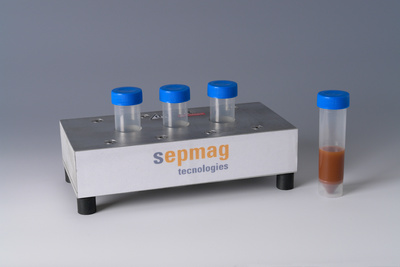The Sepmag equipment is mentioned in the Encyclopedia of Inorganic and Bioinorganic Chemistry on the chapter “Biomedical applications of magnetic nanoparticles” written by Daniel Ortega. This chapter starts with examples of several magnetic isolation methods such as the isolation of macromolecules from enzyme separation that involves immobilized affinity ligands to the removal of cancer cells from bone marrow, which is one of the most important applications of bioseparation techniques.
The general methodology of magnetic separation involving antibodies coupled with biocompatible magnetic nanoparticles is described as a three-step process. The protocol starts with binding the desired biological target to the magnetic beads, then capturing the bead complexes in a magnetic field, and finally recovering the target molecules or cells by removing the magnetic field and washing with a suitable solvent. The author recognizes that this technique is highly dependent on the spatial variation in the magnitude of the magnetic field gradient. The limitations that arise from this technical issue are the magnetic separation only being useful for processing small volume samples and low cell numbers, which is limiting. The Sepmag equipment is presented as a solution to this drawback because of its high-throughput biomagnetic separation system. Since it has a cylindrical arrangement of magnets that generates a homogeneous magnetic force outward from the center and throughout the sample, it is able to process large volume samples.
This article highlights the versatility of Sepmag equipment, which makes it possible to apply magnetic separation in a wider range of laboratorial settings. Sepmag has several options for magnetic separation, including high-throughput devices that allow magnetic separation to be applied in situations where before it was impossible.
Biomedical Applications of Magnetic Nanoparticles. Vladimir N Nikiforov, E. Y. F. Magn. Nanoparticles 393–455 (2009). doi:10.1002/9783527627561.ch10
Related news:
- Detection of Staphylococcus aureus using vancomycin coupled magnetic beads
- Detection of uranium ions in the environment with a magnetic beads-based approach
- Clinical validation of Raman scattering with magnetic beads in the diagnosis of rheumatoid arthritis





